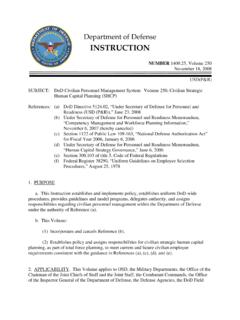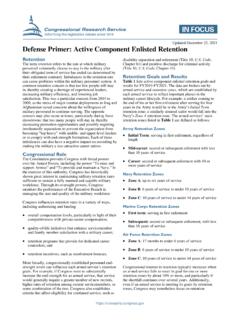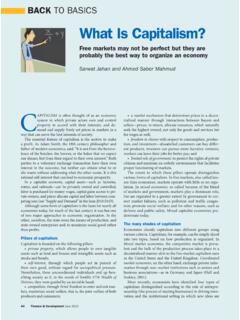Transcription of Joint Qualification System (JQS) Primer
1 DEPARTMENT OF DEFENSEJOINT OFFICER MANAGEMENT PROGRAMFact Sheet 30 Mar 2010 Joint Qualification System (JQS) PrimerREFERENCES: DoDI , DoD Joint Officer Management Program ( ) CJCSI , Joint Officer Management Program Procedures (http://www dtic mil/cjcs directives/cdata/unlimit/1330 05 pdf)WHY HAVE A JQS? --Requirements for commissioned officers to be educated and experiences in Joint matters was codified as part of the Goldwater-Nichols Act of 1986. The JQS builds upon this historic legislation by providing a structure that recognizes the expeditionary and inherently Joint nature of how military forces operate in the 21stcentury( )
2 Sections 152, 154, 155, 164, 619a, 661-668, 2151-2155, 3033, 5033, 5043, and 8033 of Title 10 United States CodeWHAT YOU SHOULD KNOW --The JQS provides Active and Reserve component officers an opportunity to earn Joint qualifications upon completion of the requisite Joint professional military education andcompletion of a full tour of duty in a Joint assignment (via either the standard path or the experience path) Transition provisions for ActiveEducationTrainingnature of how military forces operate in the path or the experience path). Transition provisions for Active Component officers end September 30, 2010.
3 Experiences that ended prior to September 30, 2009 must be submitted to the website link discussed under the Experience JQS offers 4 levels of Joint Qualification [Level I, Level II, Level III (aka Joint Qualified Officer (JQO), and Level IV] to recognize the career-long accumulation of Joint knowledge, skills, Experienceand CompetenciesSource: DoDI , Enclosure 3 OPR: ODUSD (Military Personnel Policy)Page 1 of 2 Joint Qualification System (JQS) Primer Cont dStandard Path -- Assignment to a position listed on the JDAL is considered to be the standard path to earning Joint qualifications.)
4 JDAL positions are selectively filled based on screening by the Services and the Joint organizations. Generally, officers serving in a JDAL position are O-4 and above. Except for assignments terminated by Joint duty tour length waivers or for one of the reasons listed in Enclosure 7 of DoDI , Active Component and full-time Reserve Component (RC) officers in grades O-6 and below must complete at least 3 years and G/FOs must complete at least 2 years in order to earn full Joint duty credit. The tour length for RC officers who perform duty periodically in a JDAL position is set at 6 cumulative years for O-6s and below (initial assignment not less than three years) and 4 cumulative years for G/FOs (initial assignment not less than two years).
5 DoDI , Enclosure 13 details the Officers in the grades of O-1 through O-6 may self-nominate their experiences and request award f jitiit bi thtt//d ddil/j/j i /JQSi djExperience Path y(gy),RC Joint Qualification program. A tour of duty in which an officer serves in more than one Joint duty assignment without a break between such assignments shall be considered to be a single tour of duty in a Joint duty Joint experience points by going to: Submissions are first screened and vetted by the Service Joint Officer Management (JOM) and Personnel/Human Resource staffs before being forwarded to the Joint Staff for review.
6 See DoDI , Chapter 13, for civilian credit guidelines. The Joint Staff review may either: 1) validate the experience as meeting the Joint matters standard and determine the intensity factor to be applied, or 2) recommend disapproval of the experience as clearly not having met the standard. Recommendations on each officers experiences are forwarded to the Chairman of the Joint Chiefs of Staff for approval. The Vice Director, Joint Staff, has been delegated approval authority on behalf of the Chairman. Officers in the grades of O-7 (or O-7 select) should contact their Service General or Flag Officer Matters office for details on how to self-nominate validating a position for placement on the JDAL or validating individual experiences, the criteria that must be met is the statutory definition of Joint matters both the what you do and who you do it with aspects.
7 Joint Matters the litmus matters. (1)matters related to the achievement of unified action by multiplemilitary(1) ..matters related to the achievement of unified action by multiplemilitary forces in operations conducted across domains such as land, sea, or air, in space, or in the information environment, including matters relating to (A) national military strategy;(B) strategic planning and contingency planning;(C) command and control of operations under unified command;(D) national security planning with other departments and agencies of the United States; and(E) combined operations with military forces of allied 2 of 2(2) In the context of Joint matters, the term multiple military forces refers to forces that involve participants from the armed forces and one or more of the following:(A) Other departments and agencies of the United States.
8 (B) The military forces or agencies of other countries.(C) Non-governmental persons or entities.
















